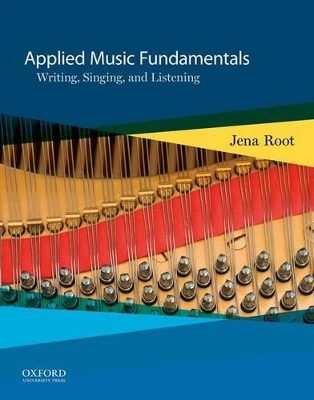
Applied Music Fundemantals
Oxford University Press Inc (Verlag)
978-0-19-984677-1 (ISBN)
context, Applied Music Fundamentals moves readers beyond mere rote memorization toward a thorough and more intuitive understanding of the key concepts that music theory students must
know.Distinctive features* Keyboard, Singing, and Hearing Exercises reinforce the crucial connection between sound and notation* "Informed Listening" examples challenge students to analyze repertoire by ear in order to foster real-time musical understanding* Short, portable "Drills to Go" help to reinforce skills and content outside of the classroom*
"Composition" exercises and "Challenge" examples give students the opportunity to think beyond the foundations introduced in each chapter and apply their acquired musical skills in a creative and personal way · Marginal icons direct students to interactive musical
examples on the book's website (www.oup.com/us/root), underscoring how listening helps them understand musical conceptsInstructors: Help your students practice and master basic music theory skills with Oxford's online Music Theory Skill Builder. Specially priced packages are available for this text. Contact your Oxford University Press representative for more information.
Jena Root is Associate Professor and Music Theory Coordinator for the Dana School of Music at Youngstown State University. She has also taught at St. Olaf College, Syracuse University, the National University of Singapore, and Shenandoah Conservatory.
Preface:
List of Informed Listening Pieces and Source Recordings:
1. Introduction to Music Notation
Chapter Goals
Elements of Music
The Staff and the Treble Clef
--Note Names in the Staff
--Mapping Notes to the Staff
--The Treble Clef
--Ledger Lines in the Treble Clef
--Replay
The Bass Clef
--Note Names in the Bass Clef
--Ledger Lines in the Bass Clef
--Replay
Rhythm and Meter
--Elements of Rhythm
--Quadruple Meter and Basic Durations
--Metric Accents
--The Dotted Half Note and Eighth Notes
--Triple Meter
--Duple Meter
--Meter Categories
--Summary of Durations
--Replay
The Repeat Sign
--Repeat Signs
--Repeat Signs with Endings
--Replay
Notation
--Clefs
--Noteheads
--Ledger Lines
--Stems
--Bar Lines and Repeats
--The Augmentation Dot
--Beamed Eighth Notes
--Time Signatures
--Note-Spacing Within the Measure
Memorization Strategies
--Pitch Name Fluency
Singing and Hearing Exercises
--Duple Meter Patterns
--Triple Meter Patterns
--Quadruple Meter Patterns
Informed Listening: Examples for Study
--Duple Meter
--Triple Meter
--Quadruple Meter
Informed Listening: Interesting Examples
Informed Listening: Examples with Questions
Drills to Go
Classroom Activities
Written Exercises
Composition
CHAPTER GOALS REVISITED
2. Pitch: The Piano Keyboard / Rhythm: Rests, Ties, and Syncopation
Chapter Goals
The Keyboard
--The White Keys of the Keyboard
--Half Steps and Whole Steps
--Replay
Accidentals
--Sharps, Flats, and Naturals
--Enharmonic Notes
--Why Do We Need Enharmonics?
--Double Sharps and Double Flats
--Diatonic and Chromatic Steps
--Replay
Octave Designation
--The Ottava Sign
--Octave Designation Numbers
--Replay
Rhythm
--Rests
--Ties
--Dotted Quarter Notes and Syncopation
--The Anacrusis (Pickup Measure)
--Replay
Notation
--Accidentals
--Rests
--Ties
--Dotted Quarter Note and Single Eighth Note
--Notation and Metric Hierarchy
Memorization Strategies
Singing Exercises
--Two-Beat Patterns
--Three-Beat Patterns
Hearing Exercises
Informed Listening: Examples for Study
Informed Listening: Examples with Questions
Drills to Go
Classroom Activities
Written Exercises
Composition
CHAPTER GOALS REVISITED
3. Pitch: Major Keys 1 / Rhythm: Beat Subdivisions
Chapter Goals
The Major Scale
--Structure and Scale Degree Names
--Replay
--Building Major Scales (up to Four Sharps or Flats)
--Replay
Major Key Signatures up to Four Sharps or Flats
--Replay
Summary of Major Key Signatures and Scales
Rhythm
--Sixteenth Notes
--Dotted Eighth Notes
--Replay
Notation
--Notes, Rests, and Beaming
--Beaming
--Flagged Vocal Notation
Memorization Strategies
--Memorizing Scale Content
--Mapping Scales to Solfège
--Practice Strategies
--Playing Scales in Tetrachord Position
--Keyboard and Singing Exercises
--Sixteenth Note Combinations
--Sixteenth Note Combinations with Leading Rests
Hearing Exercises
Informed Listening: Examples for Study
Informed Listening: Examples with Questions
Drills to Go
Classroom Activities
Written Exercises
Composition
CHAPTER GOALS REVISITED
4. Pitch: Major Keys 2 / Rhythm: Triplets
Chapter Goals
More Major Scales
--Major Scales with More Than Four Sharps or Flats
--Enharmonic Keys
--Table of Key Signatures and the Circle of Fifths
--Summary of Major Key Signatures and Scales
--Replay
The Tonic Triad and Tendency Tones
--Replay
Rhythm
--Triplets
--Replay
Notation
--Writing Key Signatures
--Writing Triplets
Memorization Strategies
--A Visual Way to Memorize Scales
--Shortcuts for Identifying Key Signatures
--A Visual Way to Memorize Key Signatures
--Flashcards
Practice Strategies
Keyboard and Singing Exercises
--Sixteenth Note Combinations and Triplet
--Sixteenth Note Combinations and Triplet with Leading Rests
Hearing Exercises
Informed Listening: Examples for Study
Informed Listening: Examples with Questions
Informed Listening: Tendency Tones in the Music of the Beatles
Drills to Go
Classroom Activities
Written Exercises
Composition
CHAPTER GOALS REVISITED
5. Pitch: Minor Keys 1 / Rhythm: Eight- and Two-Based Simple Meter
Chapter Goals
The Natural Minor Scale
--Minor Scale Structure and Relative Keys
--Replay
--Parallel Keys
--Summary of Minor Key Signatures and Scales
--Replay
Minor Scales and Solfege
--La-based Minor
--Do-based Minor
--Replay
Rhythm
--Eight-based Simple Meter
--Two-based Simple Meter
--Replay
Notation
Memorization Strategies
--Parallel and Relative Keys
--Flashcards
Practice Strategies
Keyboard and Singing Exercises
--Patterns in Three-eight
--Patterns in Three-two
Hearing Exercises
Informed Listening: Examples for Study
--Major to Relative Minor
--Minor to Relative Major
--Major to Parallel Minor
--Minor to Parallel Major
Informed Listening: Examples with Questions
--Distinguishing Major and Minor
--Major Moving to Minor
--Minor Moving to Major
Drills to Go
Classroom Activities
Written Exercises
Composition
CHAPTER GOALS REVISITED
6. Rhythm: Introduction to Compound Meter / Pitch: Minor Keys 2
Compound Meter
--Compound Meter vs. Triplets
--Counting Compound Meter
--Three-four vs. Six-eight Meter
--Songs in Compound Meter
--Replay
The Harmonic and Melodic Minor Scales
--The Natural Minor Scale (Review)
--The Harmonic Minor Scale
--Why Does the Harmonic Minor Scale Exist?
--Summary of Harmonic Minor Scales
--The Melodic Minor Scale
--Summary of Melodic Minor Scales
--Scale Degree Names in Minor
--Minor Scales in Music
--Replay
The Tonic Triad and Tendency Tones in Minor Keys
--Replay
Notation
Keyboard and Singing Exercises
--Compound Meter Patterns
--Compound Meter Patterns with Leading Rests
Hearing Exercises
Informed Listening: Examples for Study
Informed Listening: Examples with Questions
Drills to Go
Classroom Activities
Written Exercises
Composition
CHAPTER GOALS REVISITED
7. Pitch: Intervals / Rhythm: Compound Meter Review
Chapter Goals
Interval Number and Quality
--Replay
Major, Minor, and Perfect Intervals
--Replay
Melodic and Harmonic Intervals
--Replay
Recognizing Major, Minor, and Perfect Intervals
Building Major, Minor, and Perfect Intervals
--Building Intervals Above a Given Note
--Building Intervals Below a Given Note
Augmented and Diminished Intervals
--Replay
Summary of Interval Qualities
Doubly-augmented and Doubly-diminished Intervals
Inversion
--Diatonic Melody Inversion
--Chromatic Melody Inversion
--Interval Inversion
--Replay
Enharmonic Intervals
Compound Intervals
Other Interval Patterns
--Intervals in the Descending Major Scale
--Intervals in the Natural Minor Scale
--Replay
--Notation
Memorization Strategies
--Interval Shapes
--Letter-name Distances
--Plain Interval Qualities
Identifying Intervals in a Musical Context
Keyboard and Singing Exercises
Hearing Exercises
Informed Listening: Examples for Study
Informed Listening: Examples with Questions
Drills to Go
Classroom Activities
Written Exercises
Analysis and Composition
CHAPTER GOALS REVISITED
8. Pitch: Triads / Rhythm: Four- and Sixteen-Based Compound Meter
Triad Structure and Quality
--Major Triads
--Minor Triads
--Augmented Triads
--Diminished Triads
--Summary of Triad Qualities
--Replay
Triad Inversions
--Replay
Identifying Triads in a Musical Context
--Replay
Sixteen- and Four-based Compound Meter
--Sixteen-based Compound Meter
--Replay
--Four-based Compound Meter
--Replay
Summary of Common Meter Types
--Simple Meter
--Compound Meter
Memorization Strategies
--Recognizing Triad Qualities
--Hearing Triads in Root Position
--Recognizing Triad Inversions by Sight and Sound
Keyboard and Singing Exercises
--Patterns in Six-sixteen
--Patterns in Six-four
Hearing Exercises
Informed Listening: Examples for Study
Informed Listening: Examples with Questions
Informed Listening: Challenging Examples
Drills to Go
Classroom Activities
Written Exercises
Composition
CHAPTER GOALS REVISITED
9. (Postlude) Pitch: Diatonic Triads / Rhythm: Advanced Rhythmic Concepts
Chapter Goals
Diatonic Triads in Major Keys
Diatonic Triads in Minor Keys
--Replay
Harmony
Labeling Triads in Music
Diatonic Triad Functions
--Primary Triads
--Introduction to Voice Leading
--Secondary Triads
--Replay
Advanced Rhythmic Concepts
--Irregular Meter
--Subtriplets and Supertriplets
--Irregular Tuplets
--Duplets and Quadruplets
--Hemiola
--Replay
Singing Exercises
Hearing Exercises
Informed Listening: Examples for Rhythm Study
Informed Listening: Classroom Activity
Drills to Go
Written Exercises
CHAPTER GOALS REVISITED
CODA
APPENDIX A: ALTO CLEF AND TENOR CLEF:
APPENDIX B: SINGING PITCH NAMES:
APPENDIX C: CHROMATIC SOLFÈGE SYLLABLES:
APPENDIX D: MODES:
APPENDIX E: SEVENTH CHORDS:
GLOSSARY:
Index:
| Erscheint lt. Verlag | 20.9.2013 |
|---|---|
| Verlagsort | New York |
| Sprache | englisch |
| Gewicht | 1380 g |
| Themenwelt | Kunst / Musik / Theater ► Musik ► Musiktheorie / Musiklehre |
| ISBN-10 | 0-19-984677-4 / 0199846774 |
| ISBN-13 | 978-0-19-984677-1 / 9780199846771 |
| Zustand | Neuware |
| Haben Sie eine Frage zum Produkt? |
aus dem Bereich


